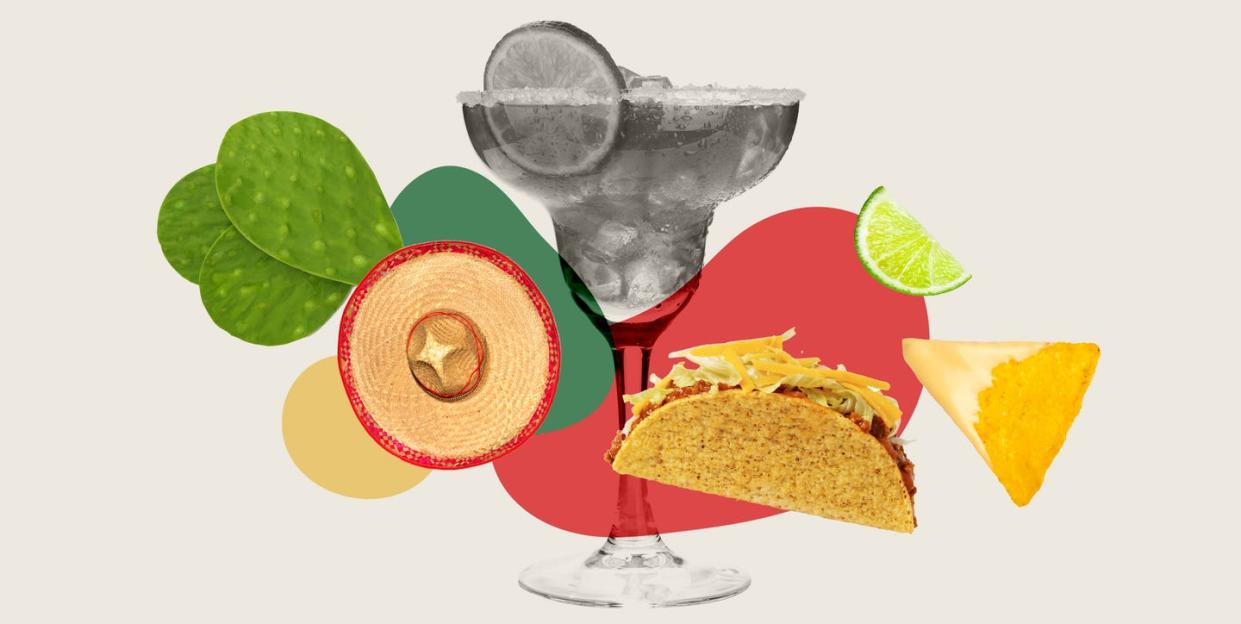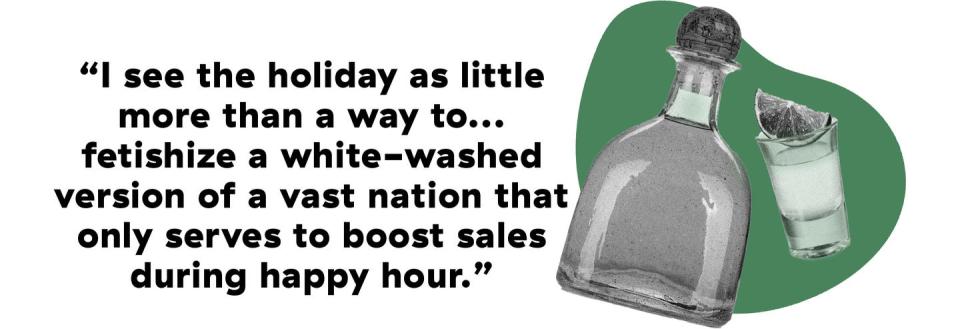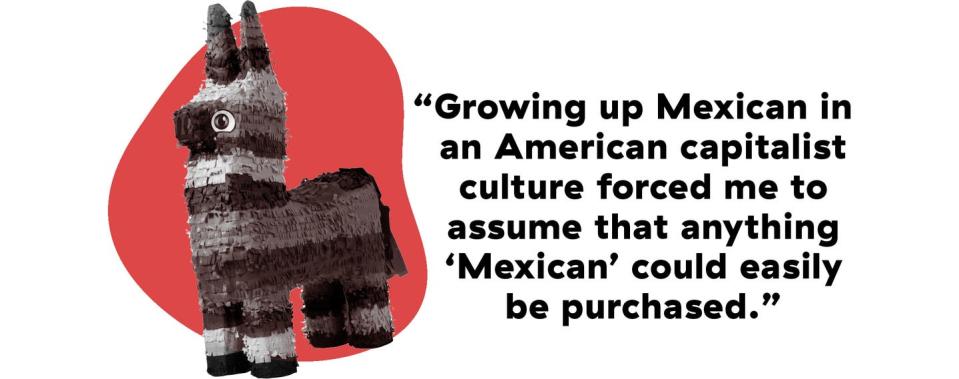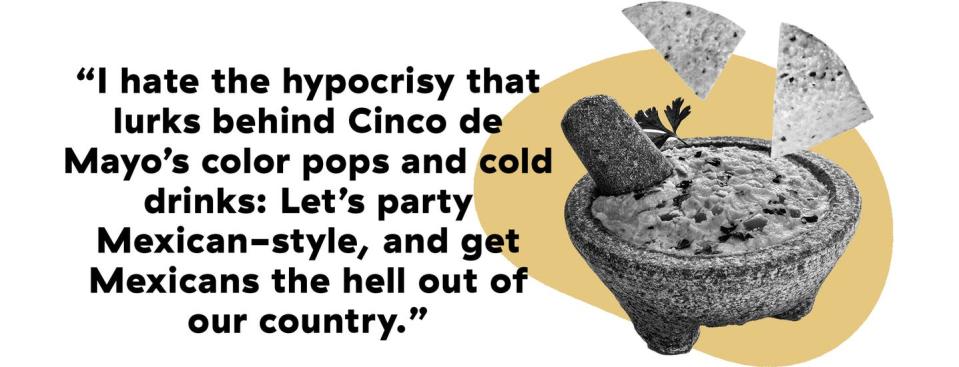Put Down The $1 Margarita

Ask Mexican Americans for their thoughts on Cinco de Mayo, and you'll soon find that it's a thorny, complicated subject. While the May 5th holiday originally celebrated a pivotal 19th-century Mexican victory over imperialist French forces, today it's more widely observed in the United States than in Mexico—and more likely by white, margarita-drunk happy hour attendees than Mexican Americans.
We here at Delish are certainly guilty of reducing Cinco de Mayo to a colorful, queso-filled excuse to eat and drink Mexican food. Peruse our site, and you'll find plenty of Cinco de Mayo-themed tequila recipes and calls to "get this fiesta started" with cheesy Mexican-inspired appetizers. But a growing chorus of Mexican Americans are pushing back on how Cinco de Mayo is observed in the U.S., and their arguments—while perhaps hard for some people to hear—make a lot of sense.
Mainstream America is often completely unaware of Cinco de Mayo's origins, they say. Without context, something as innocuous as a $1 taco deal can easily teeter into caricature—something intended for the entertainment of white audiences, not the uplifting of Mexican Americans. And how believable is a day supposedly celebrating Mexican heritage when Mexican Americans and other Latinx groups are marginalized during the remainder of the year?
We asked three writers of Mexican descent to explain these complex takeaways and more—and make the case for changing how America celebrates Cinco de Mayo.
Andrea Aliseda Irene Franco Rubio Lesley Telléz
Andrea Aliseda
Finding Meaning In Cinco de Mayo

It’s no secret that Cinco de Mayo is colloquially known in the United States as “Cinco de Drinko.” When I first encountered it at age seven, when I moved from Tijuana to the U.S., I was deeply confounded. It wasn’t Mexican Independence Day, even if it was being celebrated as such. Que chingados was Cinco de Mayo?
This was my first impression: Gringillos donning cartoonish versions of my culture, touting big sombrero hats, zarapes and fake thick synthetic black mustaches while chugging soccer ball-sized mixed margarita drinks marketed to disguise mixto tequila—a subpar version cut with non-agave sugars, which yields an infamously cheap, burning spirit that delivers gnarly hangovers.
Was I missing something? I had no memory of this in Tijuana. Cinco de Mayo was just another spring day, a day to clean my room, bug my little brother, do my homework, or do nothing at all.
This isn’t to say that Cinco de Mayo has zero significance to Mexican people. Though it commemorates just one battle––one that stopped what could have become a war––it certainly speaks to gargantuan Mexican strength, bravery and intelligence. It’s a story of how a mighty few defeated the many.
It goes like this: In 1861, Benito Juárez, who is of Zapotec descent, was president of the Mexican Republic. The country was in financial despair after a civil war that lasted from 1858 to 1860. Called the “War of Reform,” it was a struggle between the liberals and conservatives. Liberals claimed victory, but by the end of 1861, French Emperor Napoleon III decided to strike while the country was at its most vulnerable. He intended to restore conservative power with an army of 6,000 French troops, who were dispatched to the city of Puebla, the bread basket of Mexico. According to History.com, Juárez rallied 2,000 civilians, “many of them either Indigenous Mexicans or of mixed ancestry,” to defend the nation. Combat lasted only a day; 500 French soldiers were killed, but only around 100 Mexican lives were lost. Today, the miraculous feat is celebrated in Puebla and called, “Día de la Batalla de Puebla,” or “The Day of Puebla’s Battle.”
Still, it’s a holiday strangely observed more ardently in the U.S. than in Mexico. The Indiana Historical society may have an answer as to why: Fifteen years before the Battle of Puebla, the Treaty of Guadalupe Hidalgo, which ended the Mexican-American war in 1848, stripped many Mexican people of their identity and nationality overnight. In accordance with the treaty, Mexico ceded to the U.S. more than half its territory, now parts of present-day Arizona, California, New Mexico, Texas, Colorado, Nevada, and Utah.
When those people got wind of a victorious battle all those miles away, they swelled with pride. I can imagine that after suffering the sudden loss of your nationhood, after experiencing war and being disenfranchised in what used to be your home, news of an incredible Mexican victory would be reason enough to celebrate and raise one’s spirits.
And yet, by the time I was introduced to the holiday over a hundred years later, the event’s history had been watered down and appropriated by a culture to which it didn’t belong. Instead, its original significance was lost in a sea of cheap, bastardized menu items. These days, I see the holiday as little more than a way to capitalize on my culture, to fetishize a white-washed version of a vast nation that only serves to boost sales during happy hour. “Pretend to be Mexican for a night,” the marketing dully suggests.

It’s created the puzzling feeling that this holiday doesn’t belong to me, even as it celebrates my country—and a victory worthy of reverence. So I typically avoid restaurants and bars that obnoxiously celebrate this day like a vampire avoids the blazing spears of sunlight.
Still, I’d be remiss not to share that in my vampiric cave, away from the crowds of culture-vultures looking for a reason to get absolutely shit-faced, I did celebrate when the pandemic first hit. Maybe out of irony, or a craving for tacos, or for cultural communion.
Together with my next-door neighbors, also Mexican Americans, we reasoned that we celebrate our culture all the time, anyway—why not on the fifth of May? Faced with the agony of pandemic life and internal strife conjured by the holiday, we did what Mexican tradition has always taught us to do: Find humor in the humorless. And so we drank exquisite mezcal (prescribed for everything good and everything bad), perfumed the crisp spring air with nostalgic music on our respective Brooklyn balconies, and delighted in mushroom tacos paired with smokey molcajete salsas. We told stories, cracked jokes, and sang along to favorite songs as the sun began to drop in the May sky.
Without the gaudiness of the co-opted version of this holiday, we celebrated our culture in peace—unblemished, renewed, mezcal-tinged—and that was its own victory.
Andrea Aliseda (she/her) is a Mexican-American writer and vegan recipe developer based in Los Angeles, CA, and her work has been published by Whestone, Epicurious, Refinery29, Food Network, and more.
Irene Franco Rubio
The Legacy Of Cinco de Mayo, From Taco Bell To The Chicanx Movement

In 2016, when the racist and oppressive rhetoric against Mexicans hit full tilt during he-who-shall-not-be-named’s presidential run, I thought to myself: “If these racist white people hate Mexicans so much, why are they always so obsessed with Mexican food, culture, and vacationing in Cabo?” Of all the questions surrounding race and politics I later came to ask myself, that’s the one to which I could never find an answer.
Well, that’s not entirely true. I understand why an obsession with Mexican food is so prevalent. Growing up Mexican in an American capitalist culture forced me to assume that anything “Mexican” could easily be purchased. After all, Mexican culture is always available at your convenience, whether it’s making a quick stop at the store to buy a sombrero for a Cinco de Mayo-themed party or waiting in the drive-thru at Taco Bell to order a surplus of Cheesy Gordita Crunch tacos or Chalupa Supremes.

It may sound absurd to make these claims about the implications of buying sombreros and eating Taco Bell. Certainly, when one considers the trials historically faced by Mexican Americans, it’s not the worst we’ve encountered. But there’s something in the way these things are normalized that fills me with frustration.
The way I see it, when a people’s culture is constantly exploited for mass consumption, but the people who authentically embody that culture are disrespected and constantly deemed “less than,” it’s the epitome of hypocrisy. It reeks of exploitation, oppression, and capitalism.
Recognizing the history of this holiday is essential to grappling with its future. It’s also important to understand that the mainstream holiday, as it currently exists, is a function of an American capitalist system upheld by oppressive behaviors.
Often incorrectly perceived as the “Mexican Fourth of July,” Cinco De Mayo actually commemorates the 19th-century Battle of Puebla. The event saw largely outnumbered Mexican forces improbably defeat the French army, which intended to turn Mexico into a Confederate-friendly country. At the time, the U.S. was in the throes of the American Civil War. Americans living in border states—many of whom years earlier were Mexican citizens, absorbed by the U.S. during the Mexican-American War—perhaps saw themselves in Puebla’s victors. They began celebrating the event on May 5th.
It’s ironic, then, that the Cinco de Mayo of today exploits Mexican culture. Instead, Cinco de Mayo has become a commercialized event, largely celebrated by white Americans and perpetuated by capitalist systems, which are rooted in white supremacy because they thrive on the exploitation of oppressed people.
Perhaps it’s because the Latinx experience has become trendy and heavily commercialized. Suddenly it’s “cool” to be of Latin descent. But in Cinco de Mayo-themed advertisements and celebrations, spearheaded by the very systems that deem this culture as other-ed throughout the rest of the year, racism is never part of the conversation.
The mainstream version of Cinco de Mayo didn’t have to become what it is today. In the 1960s, Mexican-American communities in the U.S. began celebrating Cinco de Mayo thanks to Chicanx activists who sought to raise awareness of the holiday. May 5th became an opportunity for Chicanx people to celebrate their culture and strengthen their sense of Mexican pride in the U.S., a country that had historically discriminated against them.
At the time, the Chicanx Civil Rights Movement was a powerful force. From the East Los Angeles Walkouts that arose in protest of educators who prohibited students from speaking Spanish in school and deterred Latinx youth from pursuing higher education to the notorious work of Dolores Huerta and Cesar Chavez as co-founders of United Farm Workers, these efforts instilled a sense of pride in the Chicanx experience in the U.S. and what it meant to be of Mexican descent.
In many communities from Los Angeles to Houston, Cinco de Mayo is still celebrated as a tribute to Mexican culture and heritage, rooted in a sense of pride for their lived experience—especially in a country that has historically and actively tried to other them.
I know that the Taco Bell franchise will likely continue to flourish. Sales of sombreros will continue to soar on May 5th. For that reason, I’ll likely never celebrate Cinco de Mayo in the way American capitalist culture asks me to. Instead, I’ll focus on other year-round efforts: Centering the Chicanx experience, investing in cultural Mexican communities instead of exploiting them, and prioritizing the livelihoods of Latinx people. Those are things actually worth celebrating.
Irene Franco Rubio is a social justice activist and writer of Guatemalan and Mexican descent from Phoenix, AZ.
Lesley Telléz
A Letter To Other Mexican American And Chicanx Food Writers On Cinco de Mayo

Dear gente,
Six hundred words is not really enough to go into my nuanced feelings about Cinco de Mayo—to explain why, as I'm typing right now, I feel that acidic shame in my stomach, and why I suddenly want to cry. I’ll need meditation after I write this. A yoga class.
Why am I still allowing this? Why do I still answer the white editors who come to me this time of year, like they always do? To agree to this exchange, to say “yes” to my sense that I'm only considered valuable during Cinco de Mayo or Hispanic Heritage Month feels gross. Me da asco. And yet here I am. Because hopefully, writing this will pay for the other writing I truly want to do. And because I need to write what feels scary and hard.
The truth is: I would be happy if Cinco De Mayo melted like a giant ice cube in America’s sweaty margarita glass. I wish it was just—gone. I hate when my inbox starts getting busier at the end of April. I hate, as the date draws closer, what I might see when I open my phone: “Spice Up Your Cinco de Mayo Fiesta With These Tacos!”
It's the same phrasing, over and over. Hola, spicy, fiesta, hot. Margaritas, nachos, tacos, and beer. The lack of imagination irks me. So does the food styling, which always feels over-garnished and overdone, as if simply prepared Mexican foods like the ones my family made couldn’t possibly be good enough on their own.
Do you know what I really hate, though? As I’ve begun to face my own intergenerational traumas—a lot of it related my family’s pressure to reject our language and culture, in order to be closer to whiteness—I hate that I’m bombarded, on Cinco de Mayo, with the version of mexicanidad that white America deems palatable and acceptable.

I hate that Cinco de Mayo is their narrative. I hate the hypocrisy that lurks behind Cinco de Mayo’s color pops and cold drinks: Let’s party Mexican-style, and get Mexicans the hell out of our country. Let’s spend billions on a border wall, and let companies get rich off of surveilling immigrants, and dehumanize people crossing the border. But, let’s, like, drink margaritas and eat tacos in their honor once a year.
Did border officers force my great-grandmother to strip and take a bath, when she crossed over in El Paso in the 1920’s? I don’t know. Maybe. I'm sorry if this brings up trauma for you, too. Cinco de Mayo sort of leads me there.
I think what truly disturbs me is the message that Cinco de Mayo sends—the fact that my mexicanidad, however I define it, will never be good enough for them. We encompass worlds, but we will never be accepted by white America on our own terms.
Whew! Did she just go from Cinco de Mayo to white supremacy? Yeah. I did. I’ve come to realize, as a middle-aged woman, that I need to feel and say these things, and not bury them like I’ve done for decades. I’ve been learning, through meditation, therapy, and a group I’m in called Decolonial Alchemy, that it’s safe to feel pain. I just don’t want to live there, as my Decolonial Alchemy teacher Dra. Rocío Rosales Meza says. My medicine is needed. So is yours.
So on May 5th, I’ll be gentle with myself. I’ll stay off the Internet. I’ll walk my daughter to school while the air is still crisp. I’ll acknowledge my favorite tree, and the soft cups of the tulips, and the tiny leaves being birthed on branches. I’ll delight in the electric green color of the Japanese spindle plant I always pass on my walk home, and I’ll remember that just like the nature that surrounds us, that is us, we’ll keep growing, and shining, and radiating our real selves, even if it’s just one season at a time. I will keep showing up to the page—not for them, but for me.
With love,
Lesley
Lesley Téllez is a writer based in New York City.
You Might Also Like

